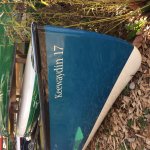Mike, if you're willing to pony up $3000-$4000 for a new build, my best recommendation for you is very strong: get the lightest weight layup available for the hull you want.
Don't be put off by the material or by foam ribs or foam sandwich bottoms. The hull will last you the rest of your life if used with care on low friction waters.
My recommendation for lightest possible weight is based on my experience with aging, and on assumptions about your paddling preferences and paddling venues plus things we've talked about.
In my experience, one's energy, strength and motivation declines much more rapidly from 60-70, your upcoming decade, than from 50-60. After that, the decline steepens further. I don't even want to think about lifting my 60-85 lb. boats anymore, even though I'm still pretty strong for my age. I'll never portage them again. The open canoe I use the most for day paddling -- which is, by far, my most common form of paddling -- is my lightest weight boat, a Bell black/gold Wildfire, which isn't all that light at about 37 pounds.
The assumptions I make about you are these:
1. I don't recall in your collection is a really lightweight canoe that you can just flip on the truck or the wife's car and go for a quick day trip. Not having a lightweight canoe will more and more become a deterrent to doing day trips. By day trips, I mean trips from home, car camping or base camping: in other words, non-hull-full-of-gear trips.
2. You don't need super durability. You are not a whitewater paddler. You are not a remote Canadian wilderness river paddler. In the greater I95 area below the Mason-Dixon line, you are mostly on bays, brown water, black water and other low friction flat waters. On your trips north, you seem to gravitate toward lakes for day tripping and base camping. You are experienced and careful. On all these venues, even the lightest weight layup, with care, should last you the rest of your life. When you are planning to paddle high friction or high impact waters, just use one of your many plastic boats.
3. You don't really need a new canoe for long, gear-heavy trips on places like big Western rivers. You have many such canoes. You don't really need light weight on those big waters either. Indeed, I don't think multi-day, multi-portaging trips are your favorite cup of joe. Your existing fleet can handle no-portage long trips. So, I think you should focus on your real usage need for a new boat, which takes me back to point #1: What I think you need is a new quick tripping canoe, not a new long tripping canoe.
4. You will probably favor a stable solo canoe in the 15.5'-16'5' range with at least a 34" beam. That's a large solo hull, which again argues for the lightest weight layup possible.
5. You will double blade it from a sitting position; hence, you can sit closer to the bottom than the stock central seat for a 16' canoe. If my assumption is correct that this canoe will be primarily be used more as a day cruiser than a long tripper, then you can choose a hull that has less depth and less initial stability than you would otherwise choose for a long tripping hull -- and hence less material and less weight.
6. You will inevitably add weight with a bunch of McDIY modifications. That again argues for keeping the base composite hull as light as possible. (Pay to have your utility thwart made of carbon over foam, unless you can make one yourself that won't uglify your new trophy hull.)
7. You are very used to carrying multiple hulls on a vehicle. Pare this down to two boats. The new light boat will be the day tripper, quick tripper, and long tripper when on low friction flat water. You can even rig it with a lightweight sail. One of your existing heavy hulls will be your durable long tripper or beater boat for high friction waters, perhaps with heavier weight and more sophisticated sail gizmos.
I researched
these canoes for you a while back. If I were you, I'd probably be looking at the two lightest weight hulls made for the Savage River Deep Creek Solo and the Swift Keewaydin 16. That is, if you want to pony up ~$3500. Which I think you should, if you can. Canoeing is a huge part of your life investment, none of us knows how much life is left to us, and you can't take it with you.

